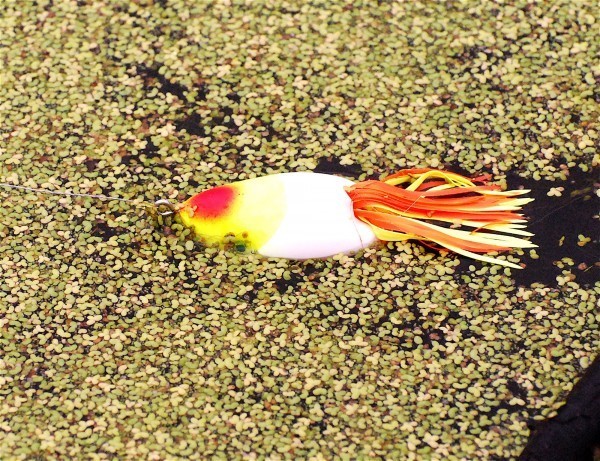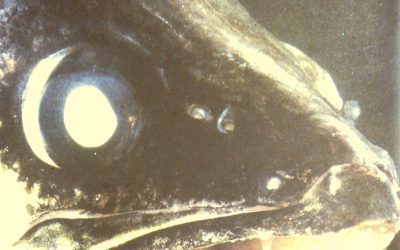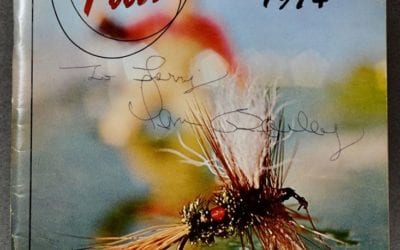A Scum Frog floats in the duckweed ready to do battle with a lunker largemouth which is sure to be lurking nearby.
Journal photo by Larry Myhre
Reprinted from the Sioux City Journal
When that hot old July sun wraps Siouxland in its sweaty grasp, my thoughts turn to slop. Slop bass, that is.
Slop is a bass fishing term that is used to describe shallow weeds which bloom into a duckweed covered, lily pad infested, algae blooming cauldron of scum.
But for largemouth bass, this smelly conglomeration of aquatic vegetation is an air conditioned suite of the first order. Weeds provide shade and shade means cooler water and, most importantly, protection from the sun. Slop is also where the food is. It might be frogs or toads or aquatic insects. Bluegills and other panfish seek cover here, as well as most young of the year fish.
The slop is like a giant picnic table to predator bass. Anything that moves is going to get busted. Like, for instance, my Slop Frog tied onto 30-pound test super line spooled on my Ambassadeur 5000 casting crank which is affixed to a pool cue-like 7-foot graphite rod which has all the action of a telephone pole.
You see, when that hawg bass blows up on that frog and turns with it in his mouth, it is heading for the bowels of the weedbed. If you wimp out, the bass wins. No, you’ve got to lunge back like you’re trying to pull a badger out of its burrow, and crank down on that bass with all the power you have to turn him and get him on top and skate him back to you like a stone skipping across a pond.
Anything less and you lose.
Fishin’ the slop is a specialty tactic that requires special lures, special lines, tough reels and stout rods. It’s why I call this fishing,”Rootin’ in the Slop.”
I love it. It’s down and dirt bassin’. There’s no finesse. It’s just brute strength and you against the bass. And he will win much of the time.
Nothing slips the hook loose from a bass faster than a big gob of weeds on the line pressing against a big hook.
So, let’s gear up for the slop.
First, the lures. Any lure will work as long as it is weedless. Two of my favorites are the Slop Frog and the Moss Boss spoon. Throw in a few Johnson Weedless Minnow spoons and a Super Frog or two and you are in business. There is a huge variety of plastic frogs which can be rigged weedless and just about any worm or other plastic bait can be rigged weedless.
When I first started fishing the slop years ago, my favorite lure was a Jumbo Pork Frog hooked onto a big weedless hook. I’d cast it far back into the weeds and retrieve as soon as it hit the surface. I would skitter it across the top of the weeds keeping all of the line off the water. I called it “dry line” fishing.
When a bass blew up on it, I’d drop the rod tip to throw some slack into the line and let the bass turn away. Then I’d really yank the rod tip up and crank down hard ’til I felt the bass.
And, just so you know. Nothing has changed. That’s exactly how you want to fish any of the more modern slop lures today. When bass hit topwater, you have to let them turn. Striking too quickly means missed fish. I’ve had lots of lessons in that regard.
Now, let’s talk line. Super lines have two huge advantages over monofilament. First of all, they are strong and rugged. Just what you need for sluggin’ it out in the shallows. Use 30-pound test, minimum. Second, they are small diameter. That helps you saw through weeds that would simply bog down 20-pound-test mono. And, by the way, don’t use a mono leader. Tie direct to the lure.
Your reel needs to be strong, like a winch. That means casting reels and the slower the retrieve rate the better.
Rods need to be long and strong. Extra heavy is about right, flippin’s sticks are about as light as you should go. A 7 footer will do nicely. It will help you lever that bass back onto the surface where you can water ski him back to the boat. If you let him dive back down into the weeds you’ll probably lose him or he’ll become so tangled you’ll have to go in and dig him out with a pitchfork.
“Rootin’ in the Slop” isn’t sporting you say? The fish doesn’t stand a chance, you say? I say try it, and you’ll find out. You will lose more bass than you bring to the boat. Breaking off a fish because you used too light of tackle is about as unsportsmanlike as it gets. Leaving a bass in the water with a big lure stuck in his mouth is something to avoid.
But you want to play with your fish? Well, play with him when you winch him into the boat. And then turn him loose to fight another day.
If you are gonna go rootin’ in the slop you gotta climb down from your high horse and rub shoulders with the great unwashed. It’s street level bassin’ and you’re gonna get dirty and your gear is gonna get dirty and your boat is gonna fill up with stinkin’ weeds and algae slop and witch’s hair.
If it’s done right you’ll have to drop the boat off at the car wash when you’re done, and it wouldn’t hurt you to walk through it, too.
Smellin’ like swamp gas is not going to win you any friends at home even if your thumb is torn up by bass teeth and you are wearing a smile that would shame a gator. Then again, “Rootin’ in the Slop” is not about winning friends. It’s about catchin hawgs in the reeking ghettos of our sunburned, sweaty summer playgrounds.
I’ll see you there.






0 Comments